|
|
| |
|
|
|
|
| |
Big Trees: Pictures & Politics |
|
|
|
| |
|
|
|
|
| |
From Sacred Symbol to Industrial Stumpage |
|
Big Trees as Recreation |
|
| |
Big Trees as Natural Monuments |
|
Big Trees as Curiosities |
|
| |
Big Trees as Cathedrals of Nature |
|
Big Trees as Commercial Products |
|
| |
Big Trees as Trophies |
|
On the Wrong Side of Environmental History |
|
| |
Big Trees as Objects of Science |
|
Greenwashing Weyerhaeuser |
|
| |
|
|
|
|
| |
|
|
| |
|
|
|
|
| |
Big Trees as Curiosities
The native North American trees of the Northwest Coast and Sierra Nevadas are among the world's largest and oldest. But because they were regarded as a natural resource to exploit by Euro American settlers, most have not survived the era of industrial logging that has deciminated over 95 percent of the native forests of California, Oregon and Washington. Surviving ancient trees, as well as the stumps of those that were cut down or fell naturally with age, have become popular tourist attractions. Among the earliest big trees to attract public interest were the giant Sequoias in the Mariposa Grove of what is now Yosemite National Park in California. The enormous prostrate trunk of the famous ancient Sequoia known as the "Fallen Monarch" (right) has been photographed by tourists for over 150 years. |
|
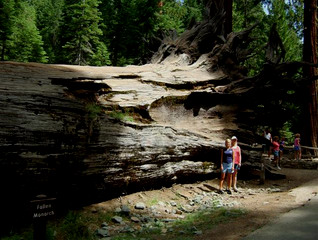
Fallen Monarch, Mariposa Grove, 2007
Yosemite National Park |
|
| |
|
|
 |
|
| |

"Father of the Forest." Engraving by C. Nahl
J. M. Hutchings, Scenes of Wonder, 1862 |
|
Also located in the Mariposa Grove was "Father of the Forest" (left), one of the first prostrate Sequoias to be illustrated in the popular press as an object of wonder and admiration. According to J. M. Hutchings, who described the "Father" in 1862, this was the largest tree in the grove: his base circumference, was 110 ft and he was estimated to have been 435 ft high when standing. Father's hollow trunk was so large that a person could walk erect inside it for 200 ft. "Around this tree stand the graceful, yet giant trunks of numerous other trees, which form a family circle," wrote Hutchings, "and make this the most imposing scene in the whole grove." |
|
| |
|
|
|
|
| |

"The Fallen Monarch," and US Cavalry, 1899
Old postcard

"Fallen Giant" and US 4th Cavalry, Merced Grove
Old postcard, c. 1900
Mounted officers of the US 4th Cavalry also posed for a postcard photo of a fallen Sequoia in the Merced Grove at Yosemite (above). The title of Fallen Monarch was given to three naturally fallen Sequoias in three different groves in the Sierra Nevadas. Reproduced as souvenir postcards, such images did much to spread the fame of the Sequoias as curiosities and increase the tourism associated with them.
A commercial image of the Grizzly Giant, copyrighted by C. C. Pierce in 1902, shows 16 mounted soldiers (F Troop, 6th Cavalry, Kansas) at its huge 39 ft in diameter base (right). Ever since the mid 19th century, when Euroamericans found the weathered age old giant tree, he was celebrated as the natural king of the forest and became an emblem of the enduring grandeur of American nature, represented by a succession of artists and photographers. German trained artist Albert Bierstadt described the art style he used to represent the venerable Grizzly Giant as "portraiture." |
|

Fallen Monarch, Mariposa Grove, 2007
Photo: Flickr
A souvenir postcard from 1899 shows some 40 Cavalry officers and their horses on top of and alongside the Fallen Monarch (left). The US Army's 4th Cavalry Regiment kept law and order in Yosemite National Park from its founding in 1890 until 1916, when the National Park Service was formed. In addition, the Cavalry often posed for publicity photos with the big trees for the Southern Pacific Railway Company. These were published as picture postcards to promote Yosemite National Park as a tourism destination.

Cavalry at Grizzly Giant, 1902
Photo: C. C: Pierce |
|
| |
|
|
 |
|
| |

"Big Trees in California"
Old postcard |
|

"Mariposa Big Trees" (click to enlarge)
Old postcard |
|
| |
|
|
|
|
| |
The most popular early forms of representation of the big trees in the Mariposa Grove were souvenir postcards (above) and stereoviews. After the transcontinental railway was completed in 1869, settlers flooded California and, to serve their growing desire to visit Yosemite Valley, a stagecoach road was built through the Mariposa Grove in 1875. To emphasize the scale of the giant trees, the log cabin built in 1861 by Galen Clark, who first set foot in the grove in 1857, was included in the scene. By 1879 four to five thousand big tree stereoviews had been produced by photographers such as Carleton Watkins who presented the awe inspiring trees as visual entertainment. His stereoview of Mariposa Grove includes Clark on a white horse (right). |
|
"In the Mariposa Grove," c. 1860
Stereoview: C. Watkins (click to enlarge) |
|
| |
|
|
 |
|
| |

"Big Trees of Kings River Canon"
Old postcard
Horses often appeared in the early photos of big tree logging which were printed as souvenir postcards such as the one entitled "Logging Team on a Felled California Giant, 26 feet in diameter" (right). Although the photo composition resembles a naturally fallen giant, the butt of the tree has been sawn and ends abruptly with no root mass. Rather than awe, the image communicates the ingenuity of man and his triumph in laying waste to the gigantic monster. |
|
It wasn't until the 1880s that the commercial cutting of the Sequoias began to take over in iconographic representation their value as magnificent masterpieces of nature. Kings River Lumber Company, renamed the Sanger Lumber Company in 1894, began production in 1888 and logged one of the most ancient stands of big trees in the Sierras, at Converse Basin in the Kings River watershed. Increasingly, macabre photos showing the chopped through massive trunks of the doomed giants were printed as postcards (left).

"Logging Team on Felled California Giant"
Old postcard |
|
| |
|
|
 |
|
| |
Sequoia National Park was established in 1890 to save some of the big tree groves from destruction by the logging industry. Fallen trees were a primary attraction of the park, one of them "Tharp's Log" (right), which continues to be visited today. A cabin was built in the hollowed out trunk of a naturally fallen giant tree by the settler Hale Tharp, who "discovered" the grove of giant Sequoias in 1858 with the help of two Yokut Indians. For many years Tharp acted as a guardian of the Sequoia grove and prevented loggers from destroying it. When the conservationist John Muir visited Tharp in 1875, he named the grove the "Giant Forest." Many of the early battles against logging occurred here, until 1890 when the beleaguered giant Sequoias were finally saved from being reduced to a meadow of big stumps. |
|

"Tharp's Log, Sequoia National Park, Calif"
Old postcard, c. 1930 |
|
| |
|
|
 |
|
| |

"The Auto Log, Giant Forest," c. 1917
Photo: Bancroft Library
A variation on the auto log that even more emphasized the subjugation of the mammoth tree was the auto stump. The chopped off remains of a majestic living entity older than the Age of Antiquities and a rare natural treasure was used as a platform for an automobile, reducing its grandeur to a mere curiostity in the form of a souvenir postcard (right). |
|
Another popular fallen Sequoia attraction in the Giant Forest was the "Auto Log," created in 1917 when Stephen Mather, first director of the National Park Service, converted the giant log into a photo stop to amuse tourists (left). Such dramatic scenes of autos parking on the prostrate corpses of fallen giant Sequoias emphasized the domination of wild nature by human civilization.

"Automobile on Stump of California Big Tree"
Old postcard |
|
| |
|
|
|
|
| |

Redwood stump, Humboldt County, 1890
Photo: A. W. Ericson |
|
By about 1900 the logged stumps of the Northwest Coast big tree species (redwood, Douglas fir, western red cedar, hemlock and Sitka spruce) had become relics of the vanquished native forests. A macabre convention was the posing of groups of children on these stumps, expressing settler society's misquided belief that domination over nature meant the destruction of these veteran trees.
In the logging town of Arcata in Humboldt County, California, one redwood stump 22 ft in diameter was memorialized on 3 May 1890 by the Swedish born settler A. W. Ericson. He photographed 42 children from the North Fork School standing on and beside the stump (left), a grotesque relic of the logging industry's abuse of nature. |
|
| |
|
|
 |
|
| |

Snohomish Stump, 1904
Photo: University of Washington
Big trees thrived in Washington State, before the settlers moved in and cut them down to convert the forests into farms. One cedar stump in Snohomish County was photographed with a community group of 20 men and three children on top of it (above). Another cedar stump at Tolt was recorded c. 1905 at the C. M. Templeton Ranch in Tolt, later renamed Carnation, King County (right). According to text on the photo, the stump was 17 ft in diameter. Its charred appearence is evidence of having survived the slash burning that followed the clearcut logging of the forest. Much of the Tolt River watershed, which provides the drinking water for the City of Seattle, was owned and clearcut logged by Weyerhaeuser until a land exchange deal in 1997. |
|

Cedar stump at Tolt, c. 1905
Old postcard |
|
| |
|
|
 |
|
| |

"A Big Stick," Seattle, Washington, 1909
Old postcard
The caption on the postcard (above) reads: "A Big Stick Holding Fifty Three Varieties at the University of Washington, Seattle, USA." This is a reference to the "Big Stick" policy coined by President Theodore Roosevelt to assert power by military force. On the verso side it stated: "This timber is 4 1/2 feet square and 74 feet long." Posing children on ancient big trees destoyed by the lumber industry for commercial profit was a cynical practice. Also dead big tree stumps were the subject of souvenir postcards. A famous cedar stump in Whatcom County often the subject of photos is seen in a 1909 postcard with a class of 25 children sitting on it (right). "Whatcom" means "noisy water" and derives from the name of an indigenous Coast Salish chief whose people had lived sustainably in the Nooksack River watershed for many centuries before the area was opened for settlement in 1854 and its magnificent big trees and ancient forests were demolished, leaving the denuded valley prone to flooding. |
|
The Northwest Coast lumber industry promoted itself in the pretentious Forestry Building at the 1909 Alaska Yukon Pacific Exposition in Seattle. Displayed next to the building was a milled Douglas fir log which was featured in a promotional postcard and official souvenir (left). The photo was taken to mark "Children's Day" on 5 June 1909 and shows an entire classroom of children sitting on the milled log which is inscribed "Tyee Logging Co., Skagit County, Washington."

Stump, Whatcom County, 1909
Old postcard |
|
| |
|
|
 |
|
| |

"Cedar Stump," Sedro Woolley, c. 1890
Old postcard
Another famous cedar stump located near Sedro Woolley was 22 ft in diameter. It was featured on a c. 1900 souvenir postcard with 31 Skagit County settlers posed on it (right).
Right: The McKinley Stump,
Chehalis, Chehalis County, Wa. Old postcard, 1907
The McKinley Stump was a popular local curiosity often reproduced in souvenir postcards. The stump came from a 350 year old Douglas fir which had been cut down near Pe Ell and moved to Chehalis as a podium for President McKinley to speak from in May 1901. His assasination meant that this event never took place. Two years later, on 22 May 1903, President Theodore Roosevelt spoke from the McKinley Stump, an event claimed as the origin of the "stump speech" metaphor. |
 |
|
|
Skagit County in Washington is named for the Skagit Coast Salish people who inhabited the Skagit River watershed. The collossal size of the big trees that once grew here is evident from the 1890 photo published as a souvenir postcard which shows a group of 72 settlers from the frontier town of Sedro Woolley posed on and around a cedar stump 60 ft in circumference (left).

"Cedar Stump, Near Sedro Woolley"
Old postcard
Already by 1879 the Skagit River watershed had been denuded of its forests; one infamous log jam was so massive that it obstructed river flow for three years. By the first decade of the 20th century, the gigantic trees seen by the early settlers had become memories. Also stumps were rare as following the industrial logging of the ancient forest the remaining debris was burned in slash piles. Stumps which were too massive to burn were dynamited and the land was converted to agricultural use. The odd stump that remained was regarded as a curiosity of bygone times. |
|
| |
|
|
 |
|
| |
Right: "The Del Norte Wonder Stump" Crescent City, Humboldt County, Ca. Old postcard of the stump with a hunter holding a rifle sitting on top. The wood products industry used the "Wonder Stump" to promote redwood lumber. From an advertisement:
"Use Redwood – It Lasts!" The Most Durable of All Building Materials. The next time you look at some Redwood lumber of old growth, free from sap, try to visualize it giving sound service exposed to the weather for 2,5000 years, say up to the year 4400. Incredible!
Yet there has been discovered up along the northern coast a Redwood tree that can be definitely proven (by the count of rings)to have lain exposed on the ground since 571 BC – exposed to a possible 75,000 inches of rainfall – exposed to fires, decay, insect attacks, and at the end of 25 centuries was cut into Shakes for a lifetime roof. |
 |
Durability has a new meaning. Redwood lumber proves to be as remarkable as the growing Sequoia. Nature made this
products, and the mills reduce it into many sizes and grades to make it most serviceable for general construction.
The Heart grades should be used where dampness in encountered, where durability is wanted. The Sap grades should only be used where lumber will be kept dry. Concrete & Stucco disintegrate; steel and iron rust; yet heart Redwood defies decay almost indefinitely. This ability to resist decay is only one of the many remarkable qualities of this wonderful wood.
Its beauty and workability make it very desirable for interior beams and ceaily effects, while its weather resisting qualities make it especially suitable for sidings, rustica and exterior uses generally. |
|
|
| |
|
|
|
|
| |
 |
 |
Del Norte Wonder Stump, c. 1930 |
Del Norte Wonder Stump, 1994 |
Big stumps were admired for their indestructible qualities. A famous example is the Del Norte Wonder Stump (above and right). It represents two generations; the upright stump was from a redwood estimated to be 1500 years in age when it was cut down for wood products. The tree had sprouted from a fallen redwood "nurse log" which was eight ft in diameter and about 1000 years old. Remarkably it was "still sound" and it too was taken to the sawmill. The stump was too large to be destroyed by the subsequent slash burning of the land and it remained as a landmark. Blazenly, logging companies used the so called "Wonder Stump" to promote the durability of redwood lumber (above). The massacre of an ancient tree that might have lived for centuries for wood products robs future generations of a biological heritage that can never be recreated and the Del Norte Wonder Stump is evidence of an appalling crime against nature. |
|

"Del Norte Wonder Stump"
Old postcard, c. 1900 |
|
| |
|
|
 |
|
| |
|
|
| |
|
|
 |
|
| |

"A Three Room Stump," Vancouver, c. 1910
Photo: BC Archives
The speed with which the giant trees were exterminated in the Vancouver area is indicated by the photo of a huge douglas fir log in which a real estate office had been set up to sell newly cleared forest lots (right). The central area of Kitsilano still had black bears living in the forests at the turn of the century as the trees were being cut down for lumber and the land sold off by property speculators, a "frontier" pattern that continues to devastate biodiversity in BC today. |
|
Within a few decades the ancient forests that had characterized the mouth of the Fraser River were ravaged for the rapidly expanding city of Vancouver in BC. A rare photo recording a vanquished giant cedar in the Mount Pleasant area shows how its stump was converted (left). The photo caption reads "A Three Room Stump House . . near Seacombe Road, Vancouver BC."

Real estate office log, Vancouver
Photo: Vancouver City Archives |
|
| |
|
|
|
|
| |

"Beautiful Washington, Big Cedar Stump"
Old postcard
Like many areas of Washington State, Lake Burien in Puget Sound, a subdivision just south of Seattle in King County was logged extensively by early settlers. Logging was done both for profit and to clear the land for settlement. Enormous profits were made by real estate agents who often operated together with the logging companies. As part of a marketing scheme for prospective buyers of a housing development at Three Tree Point, one realtor converted a big tree into an observation tower by building a circular staircase around its trunk. The standing corpse, known as Gunther's Observation Tree (right), became a landmark of Lake Burien, a sorry reminder of the giants long gone. |
|

"Gunther's Observation Tree," Seattle
Old postcard |
|
| |
|
|
 |
|
| |
Picture Gallery of Big Tree Dwellings |
 |
 |
 |
City Park Stump
Everett, Wa |
Redwood Tree Service Station
Redwood Hwy, Ca |
Stump Hotel
Crescent City, Ca |
 |
 |
 |
|
Eternal Tree House
Redcrest, Redwood Hwy, Ca |
Living Chimney Tree
Phillipsville, Redwood Hwy, Ca |
World Famous Tree House
Piercy, Redwood Highway |
 |
 |
 |
Redwood Stump House
Eureka, Ca |
Rex's Redwood Log
Redwood Hwy, Ca |
One Log House
Avenue of the Giants, Ca |
 |
 |
 |
Redwood Boot House
Redwood Hwy, Ca |
Washington Spruce Log
Palmer Park, Detroit |
Post Office Stump
Port Angeles, Wa |
 |
 |
 |
Big Tree Inn
De Moines Hwy, Wa |
Bear Den Log
Washington |
One Log House
Hoquiam, Wa |
|
|
| |
|
|
|
|
| |
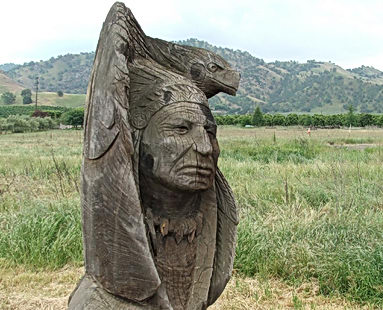
nnn
nnnnnnnnnn
In Vancouver a cedar stump at Science Park was sculpted as an enwrapped person, possibly First Nations' (left). The association of big trees with native people is not uncommon although it fails to highlight the disconcerting fact that the wrecking of the primaeval forests took place at the cost of the dispossession of the peoples who had lived in them for millenia before Europeans invaded North America and enriched themselves by this destruction. |
|
Another type of big tree curiosities are stumps that have been sculpted. These are mostly found "in situ," in the places where the big trees grew when felled. A Sequoia stump at Sequoia National Park in California is sculpted as a portrait of the Cherokee Indian chief for whom the genus is named (left).
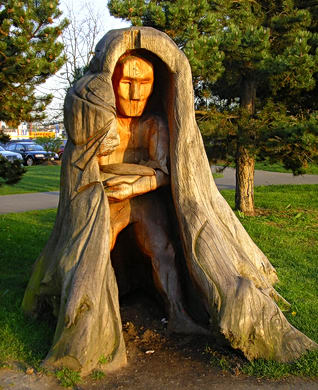
nnn
nnnnnnnnnn |
|
| |
|
|
|
|
| |
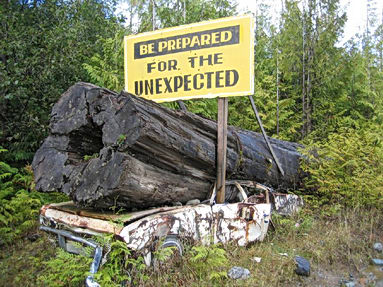
Logging company display, 2007
Vancouver Island, BC
The arrogance of the MacMillan Bloedel logging company is evident in its vulgar
display of the "world's largest burl" on Vancouver Island (right). Loggers discovered the burl in
an old growth forest in 1976. According to an information plaque, the burl grew at the base of a 350 year old
spruce tree that was 79.6. m (271 ft) in height and 1.8 m. (6 ft) in diameter. The monstrosity is marked by notches
left by the "MacBlo" fallers who cut the tree down for timber. The dead burl was then coated with
fiberglass to preserve it and "enable it to be enjoyed for years to come." It weighs 20,361 kg (22 tons)
and its circumference is 18.7 (45 ft). |
|
On Vancouver Island, home to some of the biggest trees on Earth, there has been next to
no attempt to protect the giants from the logging industry. Near the logging settlement of Holberg, on one of the
many roads constructed to facilitate the clearcut logging of the ancient forests, one logging company erected a
display (left) to warn drivers that the road is being used by logging trucks. It is crazy that while logging roads
in BC are funded by public taxes, the multinational logging companies not only control the access to the roads but
they make vast profits from the destruction of the old growth forests.
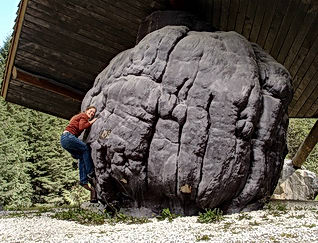
Big tree burl, courtesy MacMillan Bloedel
Vancouver Island, British Columbia |
|
| |
|
|
 |
|
| |
|
From Ancient Landmark to Relic of a Vanquished Forest |

The ancient landmark tree photographed by Kinsey (above) was later killed – not by fire as claimed – but by loggers. The tree's massive stump was then tunnelled as a roadside curiosity. In 1922 the stump was sawed at the ground, cut to 16 ft high and moved to US Highway 99 near Silvana.
Right: The relocated stump in 1922 with an inscribed plaque: "Relic of a Vanquished Forest. Western Red Cedar. Age 1250 years. Preserved at Request of Snohomish County Pioneers, Arlington, Washington, 1922." |
Left: Photo by Darius Kinsey c. 1900. Text on photo: "Cedar 20 feet in diameter, eight feet from ground. Storms of more than a thousand winters have left their imprint on this ancient landmark of the forest." Because Kinsey was often commissioned by lumber companies, his photos usually document the killing of big trees.
This photo is an exception in that it is a staged scene that celebrates a survivor of the ancient forest. Note the woman playing a quitar on the right.
 |

Above: "Giant Arborvitae," plaque with new botanical inscription.
Right: The stump on Highway 99, c. 1950. A military like row of cedar trees was planted along the road. Seen here at about 11 years old, the trees provide a stark contrast in size to the 1250 year old cedar stump which would have originally been located in a grove. |
 |
|
|
| |
|
|
 |
|
| |

"Big Cedar Stump" educational sign, 2007
Highway 99, Washington |
|

"Big Cedar Stump," 2007
Highway 99, Washington |
|
| |
|
|
|
|
| |
|
Fanciful Big Tree Stump Houses in California and British Columbia |
 |
 |
 |
Redwood Stump House
Myers Flat, Redwood Hwy, Ca |
Sitka Spruce Stump House
Queen Charlotte Islands, BC |
Redwood Stump House
Sequoia Park, Eureka, Ca |
|
|
| |
|
|
 |
|
| |
|
|
| |
©
Credits & Contact |
|
| |
|
|
|
|
|

